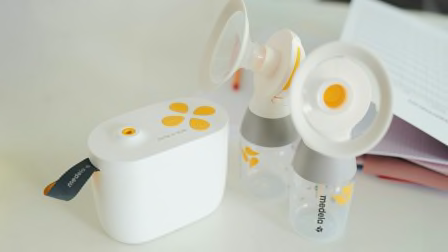9 Tips About Pumping I Wish I Had Known
Little did I know, a different flange size could make all the difference

Before I gave birth to my first child, I spent a few minutes reviewing the limited number of breast pumps sold at my registry retailer before clicking on one that was neither too expensive nor too cheap. I added it to my baby registry—just in case breastfeeding doesn’t work out, I thought.
The amount of information I didn’t know about pumping far outweighed what I had heard about it up until that moment, and was limited to the following: Pumping is your second option after breastfeeding, all breast pumps work the same way, and pumping is painful.
I didn’t bother investigating further because, I thought at the time, obviously my baby will nurse like we were both born to do it and then I’ll return the pump to the store unopened—and maybe even get some money back.
Nature had other plans for us.
Browse CR's Best Breast Pumps
This guide to the best breast pumps can help you find a model that fits your needs.
Consider a Primary Breast Pump With Lots of Options
Your first encounter with breast pumps may occur when you’re creating your baby registry—a time when the stakes feel high. This may be one of the more expensive items on your list, and you don’t want to get it wrong.
Dixon says she recommends that her clients start with a “primary pump,” which she describes as one that can be used to establish and maintain milk supply. She says they should also meet the following criteria.
Customizable: Look for a pump that has about 60 or more settings. The number of settings among pumps may vary, but Dixon says it’s important that cycle and vacuum settings can be independently determined when using the pump. Cycle refers to speed—how fast or slow the pump is going. Vacuum settings refer to the strength—how strong the pump is pulling. Dixon says she does not prefer a pump that slows down in speed anytime it goes up in strength because this gives the user fewer options to figure out what works best for their body. When the vacuum changes, the cycle can stay the same. In my research, I observed that many pumps do not advertise the total number of settings they offer (they may list massage, vacuum, or expression settings separately). Dixon created a helpful guide to determining the number of pump settings your pump features.
Not wearable: The primary pump should not be a wearable breast pump, though a wearable pump can be your go-to portable option.
Rechargeable: You should be able to use the pump and not be plugged into power.
Some pumps have only one letdown stimulation setting and one expression setting, Dixon says, and when a client goes up in the vacuum setting, it slows down in speed—this can be detrimental to some if their body doesn’t respond to that combination of settings. But a primary pump can offer cycle and vacuum settings that can be independently programmed from each other. “For me, my body prefers faster settings—I need a pump that has faster options,” Dixon says. “I can’t use slower options. I want to help women to figure out what their body may prefer.”
Although she tries out and reviews breast pumps, Dixon does not promote any one pump brand or model on her social media sites because, she says, what works for one person may not work for another.
Focus on Flange Sizes and Material
The label “hospital grade” appears on many pumps that usually have 220 millimeters of mercury (mmHg) or higher (this represents a unit of measuring vacuum pressure), according to Dixon. But the term “hospital-grade pump” is not regulated or recognized by the Food and Drug Administration and is not synonymous with a successful pumping experience. Just because a pump markets itself as “hospital-grade” does not mean it’s superior to other pumps.
In addition to finding a pump that offers more settings, focusing on getting one that comes with a flange size that fits you is crucial. “A pump could be amazing for a person and they don’t realize it, because the pump comes with 24-mm, 28-mm, 27-mm, or 25-mm [flanges],” Dixon says. “It comes with a much bigger size. So their nipples are being stretched and swollen, their nipples are inflamed, they’re turning colors: purple, blue, white. They’re causing an underlying condition called vasospasm.” Vasopasm is a “lengthy constricting, narrowing, or tightening of your artery” that “reduces blood flow through the artery, sending less oxygen than normal to nearby tissues.” According to La Leche League International, for some who experience vasopasm, the pain can be so intense that they consider stopping breastfeeding entirely.
When it comes to pumping, making sure you have the right flange size can prevent pain from happening in the first place. “I’ve had clients rebirth the entire journey by changing 1 millimeter on their flange,” Dixon says. “[One client] went from a 17-mm to a 16-mm [flange]—she’s freezing milk again.”
Even something as seemingly trivial as flange material may matter when pumping. Flanges come in hard plastic or silicone, according to Dixon, and some people’s bodies may respond differently to each material. “Some clients get half of their milk supply or less when they are in the wrong [flange] size or type,” Dixon says. When a client tells Dixon they have lower milk production, she says she troubleshoots with them by asking what type of flange they’re using and considering trying the other material.
The bottom line: Pumping is not a one-size-fits-all approach to feeding your baby.
I’ve had clients rebirth the entire journey by changing 1 millimeter on their flange. [One client] went from a 17-mm to a 16-mm [flange]—she’s freezing milk again.
CEO of Pump with Purpose
Check Your Insurance Options and State Health Department Before Buying a Pump
A quality electric breast pump can easily cost between $100 and $350, but most insurance plans are required to cover the cost of one breast pump per pregnancy.
If you’re just diving into the research, Dixon says she starts by checking what your insurance covers first. “Depending on what the insurance is, what they offer; some only offer one pump and then that’s what they have to get,” Dixon says, adding that she talks to clients about their bodies, any sensitivities, surgeries, or pain disorders they had or have before suggesting a specific breast pump.
Unfortunately, reality kicks in when I ask Dixon if there are resources available for families who lack health insurance and funds to purchase a three-figure breast pump. She is silent for a few seconds, then shakes her head and says, “No.”
The FDA considers breast pumps to be single-user devices, unless they are specifically designed for multiple users, and advises against sharing breast pumps or selling/buying used pumps because they can carry infectious particles and make you and/or your baby sick. The FDA also advises checking with your state’s health department to see whether it offers a program to help with the purchase or rental of a breast pump.
When I searched for breast pump support through the New York State Department of Health, I found links to Medicaid coverage requirements of lactation support and breast pumps (which include specifications for electric breast pumps like “Have variable/adjustable cycling not less than 30 cycles per minute”), as well as coverage required by the Affordable Care Act. Support and reimbursement for breast pumps may be offered in your state if you don’t have private insurance, but the onus is on the parent to do their research and ensure a pump meets every requirement.
Pump Smarter, Not Harder
Most breastfed newborns will eat every 2 to 4 hours, on average, and some will want to nurse as often as every 1 to 3 hours in those first few days. That doesn’t mean that more is always better when it comes to pumping. Maya Bunik, American Academy of Pediatrics breastfeeding section chair and professor of pediatrics at the University of Colorado School of Medicine, says pumping should be limited to 10 to 15 minutes and care should be taken so that it is at a comfortable setting. “Overexpression can lead to oversupply, which can cause the baby to get flooded with letdown at the breast and is associated with maternal mastitis,” Bunik says.
Dixon says she doesn’t like to overpump and tells her clients that if they are pumping and it is taking longer than 30 minutes in the first 12 weeks to get their breasts empty, either something’s wrong with their pump flange, products or schedule, or they potentially have an underlying condition.
Conditions such as hemorrhaging at birth or having a retained placenta, in which a part of the placenta is left behind after birth, can affect milk production—as well as more common experiences like postpartum stress. Other health conditions that can lead to a delay in milk coming in or have an ongoing effect on milk production include thyroid conditions, diabetes, polycystic ovarian syndrome, and not having enough glandular breast tissue.
If you are not producing enough milk and suspect a medical condition could be the cause, Dixon recommends visiting your OB/GYN or primary care physician. Lactation professionals can provide invaluable breastfeeding and pumping support, but they are not qualified to give medical advice, provide medical diagnoses, or prescribe medication.
Setting realistic pumping schedules that honor your milk production, your baby’s needs, and the needs of older children in your home can also help create more pumping success. Prolactin, the hormone that stimulates production of breast milk, is highest at night, which means it’s important to pump in the middle of the night, even if your baby is sleeping and you’re tempted to stay snug under that blanket (we get it).
If you are exclusively breast pumping and aren’t emptying your breasts of milk at this time, Dixon says, your body will get the message that all of that milk is not needed, so it will send a signal to your brain not to make as much milk, thereby lowering your milk production over time. (Note: This is called the feedback inhibitor of lactation.)
If you have older children and struggle with juggling exclusive pumping or pumping and breastfeeding with tending to their needs—because you aren’t a superhero or an octopus—Dixon offers a smart tip. While some lactation experts may recommend pumping and breastfeeding at the same time, Dixon says she doesn’t advise this because some babies need to feed from both breasts. Instead, she shows her clients (and demonstrated for me) how to pump using two flanges attached to both breasts that empty milk into two separate bottles while you are simultaneously holding your baby upright on your lap and feeding them pumped milk from a previous pumping session from a third bottle. The benefit of this method is that, instead of it taking 1 hour to feed your baby, it can take just 30 minutes—giving you back time to spend with your other children (or just relax).
Introduce a Pump Sooner to Complement Breastfeeding
Pumping and breastfeeding are sometimes set up as having an almost combative, either/or relationship with one another—as in: If you are nursing, pumping should only be considered when you go back to work or when you want to go out for a night and a babysitter will have to handle feeding your child.
If you want to breastfeed and pump (not just exclusively pump), introducing a bottle too soon may thwart your goals. “General recommendations are to wait (if possible) for the first few weeks till mother’s milk supply is established (usually by week three or four) because some babies develop a preference for the faster flow in the bottle,” Bunik says. “It is unpredictable and challenging to get babies back to nursing if they develop this preference.”
Even if you are waiting for three to four weeks to introduce a bottle (if you plan to both pump and breastfeed), you can still pump during that time. Babies nurse until they are full—not until the breast is emptied—and will remove, on average, just 67 percent of the available milk during a nursing session. There is research that shows the fuller breasts become, the more milk production slows, but milk production speeds when breasts are drained more fully. But there’s an obvious dilemma: If your baby is full, you can’t force them to keep feeding until your breasts are empty of milk.
This is where Dixon says a pump can come in and help you remove the remaining milk from your breasts. You can then store breast milk at room temperature for up to four hours, in the fridge for up to four days, or in the freezer for about six months (although 12 months is acceptable, according to the Centers for Disease Control and Prevention).
But waiting to start pumping until you have a night out planned may cause additional anxiety (one review shows psychological distress may impair the release of oxytocin, which may affect milk supply). Dixon says the most stressful thing parents do is, the moment they have to go on a trip or want to enjoy a date night, they come to the pump “aggressively” and expect it to just produce the amount of milk they’re used to giving their little one.
“After you just spent the last eight weeks telling your body you don’t need any of the milk that you did not pump out, then you expect the pump to just give it to you again magically because you started pumping,” Dixon says. “It is so dismissive that we tell these women to only pump when you need to go somewhere. They hate pumping by this time, because they’re only pumping for survival.”
Figure Out the Root Cause of Low Milk Supply
Herbal supplements are big business—there’s little oversight, and products aren’t usually regulated by the FDA prior to entering the marketplace (after products are on the market, the FDA works to ensure that dietary supplements meet applicable safety standards and that they are well-manufactured and accurately labeled). Dixon says many people she works with turn to supplements when they feel their milk production isn’t high enough. Dixon encourages her clients to instead get to the root cause of why that might be happening (including wearing flanges that don’t fit, having an underlying health condition, or not pumping frequently enough or at the right times).
“This world of people spending, and spending, and spending on all these herbals,” Dixon says. “And I keep telling them something’s wrong with your pump flanges, products, and schedule. You can take all the herbals you want—it is not going to make a difference. Something’s wrong with your blood; you are going to need to fix the blood. Herbals are not going to fix that. If you have depletion in your vitamin levels and your mineral levels, herbals are not going to help all the time.”
Cleveland Clinic recommends always consulting a healthcare provider before using herbal products, and says: “Many can also be dangerous for people who are pregnant or breastfeeding (chestfeeding). People taking medication or who are pregnant or breastfeeding should never take herbal supplements without a healthcare provider’s guidance.”
Invest in a Variety of Pumps, If Needed
Dixon always recommends a primary pump with 60 or more settings to start. As you continue on your pumping journey, you may find that one pump is plenty. But if you are planning to exclusively pump and are going back to work, you may find it convenient to add a second portable pump that you keep at work, or even discreet wearable breast pumps that do not contain tubing and provide more freedom of movement. Keep in mind though, that wearable pumps may not empty like traditional flanges, Dixon says, and Mona Gabbay, a physician and breastfeeding expert at thebreastfeedingdoctor.com, says she doesn’t recommend them if you’re trying to increase low milk production.
Remember: Pumping Is Breastfeeding, Too
More often than not, pumping is a second choice—more than 89 percent of “exclusive breast milk pumping” parents choose to exclusively pump after unsuccessful attempts at breastfeeding. And there’s no denying the benefits a baby can only get from breastfeeding, which include a baby’s ability to signal to the mother (through their saliva while direct nursing) that they need certain immune protections that come from the live cells and the associated immune factors (IgA, IgG, Lactoferrin and some other substances) in human milk from the mother, Bunik says. Other known benefits of breastfeeding include lower risk of infectious diseases and blood pressure later in life, improved cognitive performance, and one study found salivary cortisol levels decreased after breastfeeding, resulting in a reduction of stress in mothers.
But there are several reasons parents choose pumping—or pumping chooses them—and feeling like a “failure” at Plan A needn’t be one of them. “Nursing is what most people expect or want people to do when they are starting their journey,” Dixon says. “There’s just an assumption that every baby’s going to be able to nurse well and every mom is going to be able to actually have their baby nurse well.”
Reality can look different, though. If you develop an infection while giving birth or your baby becomes sick after birth and is being cared for in the hospital’s neonatal intensive care unit, you may be temporarily separated and unable to breastfeed. When this happened to Dixon, she says she was given a breast pump—but wasn’t taught how to use it. Your baby may not latch well at first, or may have tongue-tie that prevents them from latching. You may continue breastfeeding through difficulties without considering a pump, and only find out about problems like these after a trip to your pediatrician. “A lot of times, a lot of parents do not find out what’s going on until after the baby’s weight gain is not being kept, or they’re outside of the threshold for weight gain,” Dixon says. “Then they go to see their pediatrician, they find out they’re concerned, and then a pediatrician goes into emergency mode of: ‘You need to get formula.’ If a mom has not been pumping, then of course they have to get the milk supply back up, because they didn’t know that their baby wasn’t effectively removing milk.”
It’s okay to advocate for yourself in the hospital and ask for support when pumping. And you’re not alone if nursing doesn’t work out the way you hoped and planned it would. If you do not want to feed your baby formula, pumping is a solid option—and a community of exclusive pumpers exists.
Nursing is what most people expect or want people to do when they are starting their journey. There’s just an assumption that every baby’s going to be able to nurse well and every mom is going to be able to actually have their baby nurse well.
Seek Support and Community in Your Breast Pumping Journey
Dixon, a Black woman and mother of two who has over four years combined of pumping experience on her own journeys, says she supports and helps clients from all walks of life and on every continent except Antarctica (she has had more than 2,700 clients). But she also says lactation professionals of color are few and far between and not always represented. “When I built Pump with Purpose, everything about me was: I help everyone,” Dixon says. “I will never ever deny that. But the brown and tan women of color are important, because Black women especially, our infant feeding rates are the lowest. Our mortality rates are the highest for us [meaning: Black mothers and maternal mortality rates] and our babies.” Dixon adds that women of color often seek her out to work with her because they say, “Wait a minute, you look like me,” and that there is value in having a safe space in place to work with someone who looks like them.
Information about pumping is crucial to success—as is having the right pump, flanges, and pumping schedule. But support and community is that secret sauce.
“When I meet women [who are pumping] that are six weeks postpartum, and they’re smiling and glowing, they look amazing. I’m like, ‘What? You look like a ray of light,’” Dixon says. “[It’s] because they have the village support, the community, their significant other is supportive. I could go on and on about how the level of support determines a lot.”
@consumerreports Consumer Reports and @Dr. Dianna | Pumping Expert know there's no such thing as a one-size-fits-all approach to feeding your baby. That’s why we teamed up to help make picking a breast pump easier. Learn more through the link in our bio. #babytok #breastfeeding #parentsoftiktok #parenttok
♬ original sound - Consumer Reports




















